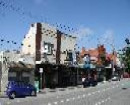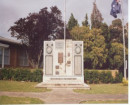Woolsthorpe Avenue of Honour
Manifold Street, Woolsthorpe VIC 3276
-
Add to tour
You must log in to do that.
-
Share
-
Shortlist place
You must log in to do that.
- Download report
Statement of Significance
The Woolsthorpe Avenue of Honour in Manifold Street, Woolsthorpe, is an avenue of Cupressus macrocarpa (Monterey Cypress) that was planted by local townspeople in honour of the local men who fought in World War I. A total of 34 men who enlisted, and this is probably the number of original trees planted. There were some species other than Monterey Cypress which were presumably already in place before the avenue of honour was planted. It is uncertain whether wooden name plates were originally part of the avenue. Some of the trees have been removed owing to senescence but these have been replaced.
How is it significant?
The Woolsthorpe Avenue of Honour in Manifold Street, Woolsthorpe, is of historical, scientific (horticultural), aesthetic and social significance to the Shire of Moyne.
Why is it significant?
The Woolsthorpe Avenue of Honour is of local social significance as a local memorial those who both served and died in the Great War.
The Woolsthorpe Avenue of Honour is of local scientific (horticultural) significance as a record of the growth and development of a particular species planted at a known time.
The Woolsthorpe Avenue of Honour is of local aesthetic significance for providing an attractive entry to the town.
-
-
Woolsthorpe Avenue of Honour - Physical Description 1
Double row of mature Cypress trees planted on Manifold Street, which are occasionally interspersed with oak trees. [LCC] - these have now been removed (2005)
There are also a number of Elms, which may be of two different species (English Elm and Dutch Elm), which appear to be remnants of an early avenue along the main road. In addition, an oak (small leafed) is either side of the road. The oaks may be the last surviving elements of the Woolsthorpe Avenue of Honour, removed in 2005. Most of the trees are very old but appear to be in good condition for their age.
COMPARATIVE ANALYSIS
Before it was destroyed in 2005, the Woolsthorpe Avenue of Honour was one of the most impressive avenue of honours in Moyne Shire. The remaining trees (oaks, elms and Aleppo Pine) together make up an important collection of street trees for the small township.Woolsthorpe Avenue of Honour - Physical Conditions
Demolished
Woolsthorpe Avenue of Honour - Integrity
Not able to assess
Veterans Description for Public
Woolsthorpe Avenue of Honour - Veterans Description for Public
The Woolsthorpe Avenue of Honour, on Manifold Street, was planted by the town in honour of the local men who fought in the First World War. A total of thirty-four men enlisted and which was the number of Cypress trees originally planted. There were some species other than Monterey Cypress which were presumably already in place before the avenue of honour was planted. Some of the deteriorating trees have been removed but these have been replaced.
The late Mary Bennett in her local history of Woolsthorpe wrote: 'The town was justly proud of its "sons" and of the fact that every eligible man had volunteered, though it left few able bodied men to work the land. Thirty-four, in all, enlisted. The Richardson family had four sons at the war, and the Lindsay family of "Quamby" farewelled three. To honour these men, the citizens planted an avenue of cypress trees along the main road, one for each soldier. Whether each tree originally had a wooden marker bearing a name, is not known, but the school children cared for and regularly watered them to make the trees grow.'
In Australia, commemorative trees have been planted in public spaces since the late nineteenth century. Arbor Days were held regularly in most Victorian State Schools during the late 1800s and early 1900s, and numerous trees were planted in parks in Melbourne and throughout Victoria to mark the visits of important and famous people.
This tradition of commemorative planting was continued in 1901 when at the end of the Boer War trees were often planted for each soldier of the district who was killed in South Africa. These plantings, however, rarely consisted of more than two or three trees in each town.
During and after the First World War avenues of honour consisting of trees lining significant streets became a popular form of commemoration. They represented a new egalitarian approach to the commemoration of soldiers where rank was not a consideration: each tree symbolises a person.
Avenues of honour are a uniquely Australian phenomenon. Australians, and in particular Victorians, embraced the idea of planting them more enthusiastically than any other country in the world. Dating from May 1916, the Eurack Avenue of Honour is the earliest known avenue of honour to be planted in Victoria.
By the time of the Second World War avenues of honour had declined in popularity as a means of commemoration. Today it is estimated that over 300 avenues of honour have been planted in Victoria to commemorate service personnel since 1901.
Heritage Study and Grading
Moyne - Moyne Shire Heritage Study Stage 2
Author: Helen Doyle in association with Context P/L
Year: 2006
Grading: Local
-
-
-
-
-
The Union Homestead
 National Trust
National Trust -
Woolsthorpe War Memorial
 Vic. War Heritage Inventory
Vic. War Heritage Inventory -
Woolsthorpe Soldiers Memorial Park
 Vic. War Heritage Inventory
Vic. War Heritage Inventory
-
1 Brockenshire Street
 Yarra City
Yarra City -
1 Bundara Street
 Yarra City
Yarra City -
1 Forster Street
 Hobsons Bay City
Hobsons Bay City
-
-
Tours involving this place See all tours
28/03/16
Woolsthorpe Avenue of Honour - Woolsthorpe Public Hall Honour Roll (Part B) - BRIDGE
Public contributions
Tours involving this place See all tours
28/03/16
Woolsthorpe Avenue of Honour - Woolsthorpe Public Hall Honour Roll (Part B) - BRIDGE












